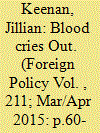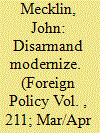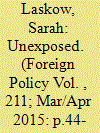|
|
|
Sort Order |
|
|
|
Items / Page
|
|
|
|
|
|
|
| Srl | Item |
| 1 |
ID:
137972


|
|
|
|
|
| Summary/Abstract |
When Pierre Gahungu thinks about the small farm in the Burundian hills where he grew up and started a family, he remembers the soil—rich and red, perfect for growing beans, sweet potatoes, and bananas. He used to bend over and scoop up a handful of the earth just to savor its moist feel. To Gahungu, now in his 70s, the farm was everything: his home, his livelihood, and his hope. After he was gone, he had always believed, the land would sustain his eventual heirs.
|
|
|
|
|
|
|
|
|
|
|
|
|
|
|
|
| 2 |
ID:
137971


|
|
|
|
|
| Summary/Abstract |
In the early decades of the Cold War, NATO made arrangements to bury what were known as atomic demolition munitions (in essence, nuclear mines) at key points in West Germany, to be detonated if Warsaw Pact forces ever invaded. Although this plan, if enacted, might have slowed the enemy advance, it also almost certainly would have turned vast West German territories into radioactive wastelands littered with corpses and smoldering buildings—the stuff of hellish alternative-
history scenarios. The West viewed such tactical nukes—NATO fielded 7,000 to 8,000 of these shorter-
range, smaller-yield weapons for most of the Cold War—as tripwires in anticipation of the Soviet Union’s own Strangelovian plans for its thousands of tactical weapons. That is to say, the forward positioning of these nukes was a signal: If the Soviet Union invaded Europe, confrontation would escalate quickly to the nuclear realm, and the United States would intervene.
|
|
|
|
|
|
|
|
|
|
|
|
|
|
|
|
| 3 |
ID:
137973


|
|
|
|
|
| Summary/Abstract |
Once upon a time, no term evoked modernity like “the Atomic Age.” It contained the promise of harnessing the power of the atom for good and for ill. Unleashing the secrets of the atom was what separated the world’s most advanced and powerful nations from the rest. This Damoclean era was ushered in 70 years ago, on July 16, 1945, with the Trinity nuclear test in New Mexico’s Jornada del Muerto desert. The name translates to “Dead Man’s Journey” — fitting, because the detonation triggered a nuclear arms race that made palpable the dark threat of planetary Armageddon. As is the case with others who grew up in the 1960s, some of my most acute, enduring memories are of a childhood shaped by nuclear fears. I was 6 years old during the Cuban missile crisis and remember going to bed at night unsettled by the air-raid drills we rehearsed at school and by the worry I saw in my parents eyes as they watched the evening news.
|
|
|
|
|
|
|
|
|
|
|
|
|
|
|
|
| 4 |
ID:
137970


|
|
|
|
|
| Summary/Abstract |
At 6:45 a.m. on March 1, 1954, the earth rumbled beneath 10-year-old Jalel John’s feet as she stood on Ailuk Atoll in the Marshall Islands. Above her, half the sky turned strange colors. She remembers, in particular, the reds—the uncanny shades of red. Within six minutes, a mushroom cloud reached 130,000 feet overhead, pulling with it the pulverized coral of islands. Left behind was a crater that measured more than a mile wide and 250 feet deep, vast enough to be visible from space. Some 350 miles away from the blast, John experienced the largest thermonuclear explosion that the U.S. military would ever detonate, a test known as Castle Bravo. (It reached a yield of 15 megatons; in layman’s terms, that’s 1,000 times more powerful than the bomb dropped over Hiroshima.)
|
|
|
|
|
|
|
|
|
|
|
|
|
|
|
|
| 5 |
ID:
137968


|
|
|
|
|
| Summary/Abstract |
As a kid in the 1960s, Jeff Held thought that having a nuclear company in his backyard made life more exciting in Apollo, Pennsylvania. About 2,400 people lived alongside the Nuclear Materials and Equipment Corporation (NUMEC), the town’s main employer. Held’s neighborhood subsisted on atomic lore: Just 33 miles down the road in Pittsburgh, the Westinghouse Corporation had helped construct the world’s first nuclear submarine, and in Apollo, NUMEC consequently manufactured the requisite nuclear fuel, a source of stirring pride minted by the Cold War.
|
|
|
|
|
|
|
|
|
|
|
|
|
|
|
|
|
|
|
|
|